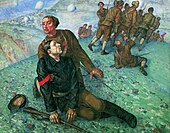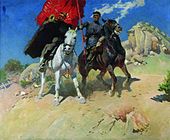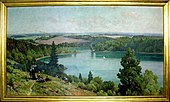Socialist realism
This article needs additional citations for verification. (April 2021) |
Kiyevskaya station in the Moscow Metro | |
| Years active | 1932 - present |
|---|---|
| Location | Socialist countries |
| Influences | Marxism, Realism |
Socialist realism was the official cultural doctrine of the
It was usually characterized by unambiguous
Socialist realism was the predominant form of approved art in the Soviet Union from its development in the early 1920s to its eventual fall from official status beginning in the late 1960s until the breakup of the Soviet Union in 1991.[7][8] While other countries have employed a prescribed canon of art, socialist realism in the Soviet Union persisted longer and was more restrictive than elsewhere in Europe.[9]
History
Development
Socialist realism was developed by many thousands of artists, across a diverse society, over several decades.
Shortly after the Bolsheviks took control,
Debate within Soviet art

There were two main groups debating the fate of Soviet art: futurists and traditionalists.
According to the Great Russian Encyclopedia, the term was first used in press by chairman of the organizing committee of the Union of Soviet Writers, Ivan Gronsky in Literaturnaya Gazeta on May 23, 1932.[14] The term was approved in meetings that included politicians of the highest level, including Joseph Stalin.[15] Maxim Gorky, a proponent of literary socialist realism, published a famous article titled "Socialist Realism" in 1933.[15] During the Congress of 1934, four guidelines were laid out for socialist realism.[16] The work must be:
- Proletarian: art relevant to the workers and understandable to them.
- Typical: scenes of everyday life of the people.
- Realistic: in the representational sense.
- Partisan: supportive of the aims of the State and the Party.
Characteristics

The purpose of socialist realism was to limit popular culture to a specific, highly regulated faction of emotional expression that promoted Soviet ideals.
There was a prevailing sense of optimism, as socialist realism's function was to show the ideal Soviet society. Not only was the present glorified, but the future was also supposed to be depicted in an agreeable fashion. Because the present and the future were constantly idealized, socialist realism had a sense of forced optimism. Tragedy and negativity were not permitted, unless they were shown in a different time or place. This sentiment created what would later be dubbed "revolutionary romanticism".[18]
Revolutionary romanticism elevated the common worker, whether factory or agricultural, by presenting his life, work, and recreation as admirable. Its purpose was to show how much the standard of living had improved thanks to the revolution, as educational information, to teach Soviet citizens how they should be acting and to improve morale. [
Common images used in socialist realism were flowers, sunlight, the body, youth, flight, industry, and new technology.[18] These poetic images were used to show the utopianism of communism and the Soviet state. Art became more than an aesthetic pleasure; instead it served a very specific function. Soviet ideals placed functionality and work above all else; therefore, for art to be admired, it must serve a purpose. Georgi Plekhanov, a Marxist theoretician, states that art is useful if it serves society: "There can be no doubt that art acquired a social significance only in so far as it depicts, evokes, or conveys actions, emotions and events that are of significance to society."[21]
The themes depicted would feature the beauty of work, the achievements of the collective and the individual for the good of the whole. The artwork would often feature an easily discernible educational message.
The artist could not, however, portray life just as they saw it because anything that reflected poorly on Communism had to be omitted. People who could not be shown as either wholly good or wholly evil could not be used as characters.[22] Art was filled with health and happiness: paintings showed busy industrial and agricultural scenes; sculptures depicted workers, sentries, and schoolchildren.[23]
Creativity was not an important part of socialist realism. The styles used in creating art during this period were those that would produce the most realistic results. Painters would depict happy, muscular peasants and workers in factories and collective farms. During the Stalin period, they produced numerous heroic portraits of Stalin to serve
Important groups

The Merriam-Webster Dictionary defines socialist realism as "a Marxist aesthetic theory calling for the didactic use of literature, art, and music to develop social consciousness in an evolving socialist state".[26] Socialist realism compelled artists of all forms to create positive or uplifting reflections of socialist utopian life by utilizing any visual media, such as posters, movies, newspapers, theater and radio, beginning during the Communist Revolution of 1917 and escalating during the reign of Stalin until the early 1980s.[27]
Vladimir Lenin, head of the Russian government 1917–1924, laid the foundation for this new wave of art, suggesting that art is for the people and the people should love and understand it, while uniting the masses. Artists Naum Gabo and Antoine Pevsner attempted to define the lines of art under Lenin by writing "The Realist Manifesto" in 1920, suggesting that artists should be given free rein to create as their muse desired. Lenin, however, had a different purpose for art: wanting it functional, and Stalin built on that belief that art should be agitation.[28]
The term Socialist Realism was proclaimed in 1934 at the Soviet Writer's congress, although it was left not precisely defined.[29] This turned individual artists and their works into state-controlled propaganda.
After the death of Stalin in 1953, he was succeeded by Nikita Khrushchev who allowed for less draconian state controls and openly condemned Stalin's artistic demands in 1956 with his "Secret Speech", and thus began a reversal in policy known as "Khrushchev's Thaw". He believed that artists should not be constrained and should be allowed to live by their creative talents. In 1964, Khrushchev was removed and replaced by Leonid Brezhnev, who reintroduced Stalin's ideas and reversed the artistic decisions made by Khrushchev.
However, by the early 1980s, the Socialist Realist movement had begun to fade. Artists to date[when?] remark that the Russian Social Realist movement as the most oppressive and shunned period of Soviet Art.[28]
Association of Artists of Revolutionary Russia (AKhRR)
The Association of Artists of Revolutionary Russia (
In 1928, the AKhRR was renamed to Association of Artists of the Revolution (AKhR) in order to include the rest of the Soviet states. At this point the group had begun participating in state promoted mass forms of art like murals, jointly-made paintings, advertisement production and textile design.
Studio of military artists named after M. B. Grekov
This section needs expansion. You can help by adding to it. (April 2021) |
Studio of military artists was created in 1934.[31]
The Union of Soviet Writers (USW)
The creation of Union of Soviet Writers was partially initiated by Maxim Gorky to unite the Soviet writers of different methods, such as the "proletarian" writers (such as Fyodor Panfyorov), praised by the Communist Party, and the poputchicks (such as Boris Pasternak and Andrei Bely).[32] In August 1934, the union held its first congress where Gorky said:
The Writers' Union is not being created merely for the purpose of bodily uniting all artists of the pen, but so that professional unification may enable them to comprehend their corporate strength, to define with all possible clarity their varied tendencies, creative activity, guiding principles, and harmoniously to merge all aims in that unity which is guiding all the creative working energies of the country.[33]
One of the most famous authors during this time was Alexander Fadeyev. Fadeyev was a close personal friend of Stalin and called Stalin "one of the greatest humanists the world has ever seen."[34] His most famous works include The Rout and The Young Guard.
Impact
The impact of socialist realist art can still be seen decades after it ceased being the only state-supported style. Even before the end of the
In the 1990s, many Russian artists used the characteristics of socialist realism in an ironic fashion.[35] This was completely different from what existed only a couple of decades before. Once artists broke from the socialist realist mould, there was a significant power shift. Artists began including subjects that could not exist according to Soviet ideals. Now that the power over appearances was taken away from the government, artists achieved a level of authority that had not existed since the early 20th century.[36] In the decade immediately after the fall of the USSR, artists represented socialist realism and the Soviet legacy as a traumatic event. By the next decade, there was a unique sense of detachment.[37]
Western cultures often do not look at socialist realism positively. Democratic countries view the art produced during this period of repression as a lie.[38] Non-Marxist art historians tend to view communism as a form of totalitarianism that smothers artistic expression and therefore retards the progress of culture.[39] In recent years there has been a reclamation of the movement in Moscow with the addition of the Institute of Russian Realist Art (IRRA), a three-story museum dedicated to preserving 20th-century Russian realist paintings.[40]
Notable works and artists
This section needs additional citations for verification. (February 2023) |
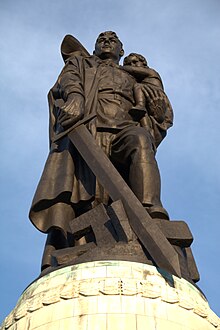
Music
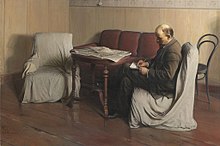
Hanns Eisler composed many workers' songs, marches, and ballads on current political topics such as Song of Solidarity, Song of the United Front, and Song of the Comintern. He was a founder of a new style of revolutionary song for the masses. He also composed works in larger forms such as Requiem for Lenin. Eisler's most important works include the cantatas German Symphony, Serenade of the Age and Song of Peace. Eisler combines features of revolutionary songs with varied expression. His symphonic music is known for its complex and subtle orchestration.[citation needed]
Closely associated with the rise of the
Film
In the early 1930s,
Socialist realism was also applied to
Paintings
The painter
Socialist realist art found acceptance in the
Literature
Martin Andersen Nexø developed socialist realism in his own way. His creative method featured a combination of publicistic passion, a critical view of capitalist society, and a steadfast striving to bring reality into accord with socialist ideals. The novel Pelle, the Conqueror is considered to be a classic of socialist realism.[citation needed] The novel Ditte, Daughter of Man had a working-class woman as its heroine. He battled against the enemies of socialism in the books Two Worlds, and Hands Off!.
The novels of Louis Aragon, such as The Real World, depict the working class as a rising force of the nation. He published two books of documentary prose, The Communist Man. In the collection of poems A Knife in the Heart Again, Aragon criticizes the penetration of American imperialism into Europe. The novel The Holy Week depicts the artist's path toward the people against a broad social and historical background.[citation needed]
Thol, a novel by D. Selvaraj in Tamil is a standing example of Marxist Realism in India. It won a literary award (Sahithya Akademi) for the year 2012.[46]
Sculptures
Sculptor Fritz Cremer created a series of monuments commemorating the victims of the National Socialist regime in the former concentration camps Auschwitz, Buchenwald, Mauthausen and Ravensbrück. His bronze monument in Buchenwald, depicting the liberation of this concentration camp by detainees in April 1945, is considered one of the most striking examples of socialist realism in GDR sculpture for its representation of communist liberation.[citation needed] Each figure in the monument, erected outside the campsite, has symbolic significance according to the orthodox communist interpretation of the event. Thus communists were portrayed as the driving force behind self-liberation, symbolized by a figure in the foreground sacrificing himself for his sufferers, followed by the central group of determined comrades through whose courage and fearlessness is encouraged. The German Democratic Republic used these sculptures to reaffirm its claim to the historical and political legacy of the anti-fascist struggle for freedom.[47]
Bruno Apitz's novel Nackt unter Wölfen, a story that culminates in the vivid description of the self-liberation of the detainees,[48] was deliberately chosen to take place on the same day as the formal opening of the Buchenwald Monument in September 1958.[47]
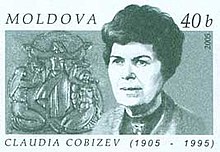
Claudia Cobizev was a Moldovan sculptor, whose work was known for its sensitive portrayals of women and children.[49][50] Her most notable work is Cap de moldoveancă which was exhibited at the Paris International Exhibition to wide acclaim.[51]
Soviet Union
This section needs additional citations for verification. (February 2023) |
In conjunction with the Socialist Classical style of architecture, socialist realism was the officially approved type of art in the Soviet Union for more than fifty years.[52]
In the early years of the Soviet Union, Russian and Soviet artists embraced a wide variety of art forms under the auspices of Proletkult. Revolutionary politics and radical non-traditional art forms were seen as complementary.[53] In art, Constructivism flourished. In poetry, the non-traditional and the avant-garde were often praised.
These styles of art were later rejected by members of the Communist Party who did not appreciate modern styles such as Impressionism and Cubism. Socialist realism was, to some extent, a reaction against the adoption of these "decadent" styles. It was thought by Lenin that the non-representative forms of art were not understood by the proletariat and could therefore not be used by the state for propaganda.[54]
Modern art styles appeared to refuse to draw upon this heritage, thus clashing with the long realist tradition in Russia and rendering the art scene complex.[58] Even in Lenin's time, a cultural bureaucracy began to restrain art to fit propaganda purposes.[59] Leon Trotsky's arguments that a "proletarian literature" was un-Marxist because the proletariat would lose its class characteristics in the transition to a classless society, however, did not prevail.[60]

Socialist realism became state policy in 1934 when the First Congress of Soviet Writers met and Stalin's representative Andrei Zhdanov gave a speech strongly endorsing it as "the official style of Soviet culture".[61] It was enforced ruthlessly in all spheres of artistic endeavour. Form and content were often limited, with erotic, religious, abstract, surrealist, and expressionist art being forbidden. Formal experiments, including internal dialogue, stream of consciousness, nonsense, free-form association, and cut-up were also disallowed. This was either because they were "decadent", unintelligible to the proletariat, or counter-revolutionary.
Art exhibitions of 1935–1940 serve as counterpoint to claims that the artistic life of the period was suppressed by the ideology and artists submitted entirely to what was then called "social order". A great number of landscapes, portraits, and genre paintings exhibited at the time pursued purely technical purposes and were thus ostensibly free from any ideology. Genre painting was also approached in a similar way.[62]
Their time and contemporaries, with all its images, ideas, and dispositions found it full expression in portraits by
In 1974, for instance, a show of unofficial art in a field near Moscow was broken up and the artwork destroyed with a water cannon and bulldozers (see
Other countries
This section needs additional citations for verification. (February 2023) |

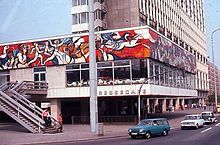
After the Russian Revolution, socialist realism became an international literary movement. Socialist trends in literature were established in the 1920s in Germany, France, Czechoslovakia, and Poland. Writers who helped develop socialist realism in the West included
During the 1950s, this massive undertaking, a crucial role fell to architects perceived not as merely engineers creating streets and edifices, but rather as "engineers of the human soul" who, in addition to extending simple aesthetics into urban design, were to express grandiose ideas and arouse feelings of stability, persistence and political power.
In art, from the mid-1960s more relaxed and decorative styles became acceptable even in large public works in the Warsaw Pact bloc, the style mostly deriving from popular posters, illustrations and other works on paper, with discreet influence from their Western equivalents.
Today,[when?] arguably the only countries still focused on these aesthetic principles are North Korea, Laos, and to some extent Vietnam. Socialist realism had little mainstream impact in the non-Communist world, where it was widely seen as a totalitarian means of imposing state control on artists.[65]
The former Socialist Federal Republic of Yugoslavia was an important exception among the communist countries, because after the Tito–Stalin split in 1948, it abandoned socialist realism along with other elements previously imported from the Soviet system and allowed greater artistic freedom.[66]
Socialist realism was the main art current in the People's Socialist Republic of Albania. In 2017, three works by Albanian artists from the socialist era were exhibited at documenta 14.[67]
China
Academics typically view China's socialist literature as existing within the trend of Stalinist-influenced socialist realism, particularly major works such as Mikhail Sholokov's Virgin Soil Upturned and Galina Nikolaeva's Harvest which were widely translated and disseminated in China.[68] Other academics, including Cai Xiang, Rebecca E. Karl, and Xueping Zhong, place greater weight on the influence of Mao Zedong's 1942 lectures, "Talks at the Yan'an Forum on Art and Literature."[69]
Gender in socialist realism
USSR
Early Soviet period

In the poster propaganda produced during the Russian Civil War (1917–1922) men were overrepresented as workers, peasants, and combat heroes, and when women were shown, it was often either to symbolize an abstract concept (e.g., Mother Russia, "freedom") or as nurses and victims.[70] The symbolic women would be depicted as feminine – wearing long dresses, long hair, and bare breasts. The image of the urban proletariat, the group which brought the Bolsheviks to power was characterized by masculinity, physical strength, and dignity and were usually shown as blacksmiths.[70]
In 1920, Soviet artists began to produce the first images of women proletarians. These women differed from the symbolic women from the 1910s in that they most closely resembled the aspects of the male workers – dignity, masculinity, and even supernatural power in the case of blacksmiths.[70] In many paintings in the 1920s, the men and women were almost indistinguishable in stature and clothing, but the women would often be depicted taking subservient roles to the men, such as being his assistant ("rabotnitsa").[70] These women blacksmith figures were less common, but significant, since it was the first time women were represented as proletarians.[70] The introduction of women workers in propaganda coincided with a series of government policies which allowed for divorce, abortion, and more sexual freedom.[71]
Peasant women were also rarely depicted in socialist propaganda art in the period before 1920. The typical image of a peasant was a bearded, sandal-shoed man in shoddy clothes and with a scythe, until 1920, when artists began to create peasant women, who were usually buxom, full-bodied, with a scarf tied around their head.[70] The image of peasant women was not always positive; they often would evoke the derogatory caricature "baba", which was used against peasant women and women in general.[72]
As is discussed above, the art style during the early period of the Soviet Union (1917–1930) differed from the socialist realist art created during the Stalinist period. Artists were able to experiment more freely with the message of the revolution.[72] Many Soviet artists during this period were part of the constructivist movement and used abstract forms for propaganda posters, while some chose to use a realist style.[70] Women artists were significantly represented in the revolutionary avant garde movement, which began before 1917[73] and some of the most famous were Alexandra Exter, Natalia Goncharova, Liubov Popova, Varvara Stepanova, Olga Rozanova and Nadezhda Udaltsova.[73][74][75] These women challenged some of the historical precedents of male dominance in art. Art historian Christina Kiaer has argued that the post-revolutionary shift away from market-based art production was beneficial to female artists' careers, especially before 1930, when the Association of Artists of Revolutionary Russia (AKhRR) was still relatively egalitarian.[76] Instead of an elite, individualistic group of disproportionately male "geniuses"[77] produced by the market, artists shared creation of a common vision.[76][clarification needed]
Stalin era
The style of socialist realism began to dominate the Soviet artistic community starting when Stalin rose to power in 1930, and the government took a more active role in regulating art creation.[78] The AKhRR became more hierarchical and the association privileged realist style oil paintings, a field dominated by men, over posters and other mediums in which women had primarily worked.[76][78] The task of Soviet artists was to create visualisations of the "New Soviet Man" – the idealized icon of humanity living under socialism. This heroic figure encapsulated both men and women, per the Russian word "chelovek", a masculine term meaning "person".[73] While the new Soviet person could be male or female, the figure of man was often used to represent gender neutrality.[79]
Because the government had declared the "woman question" resolved in 1930, there was little explicit discourse about how women should be uniquely created in art.[80] Discussions of gender difference and sexuality were generally taboo and viewed as a distraction from the duties people had to the creation of socialism.[71] Accordingly, nudes of both men and women were rare, and some art critics have pointed out that Socialist Realist paintings escaped the problem of women's sexual objectification commonly seen in capitalist forms of art production.[71][81] But the declaration of women's equality also made it difficult to talk about the gender inequality that did exist; Stalin's government had simultaneously banned abortion and homosexuality, made divorce more difficult, and dismantled the women's associations in government (Zhenotdels).[71] The "New Soviet Woman" was often shown working in traditionally male jobs, such as aviation, engineering, tractor-driving, and politics.[79] The point of this was to encourage women to join the workforce and show off the strides the USSR had made for women, especially in comparison with the United States.[82] Indeed, women had expanded opportunities to take up traditionally male jobs in comparison to the US. In 1950, women made up 51.8% of the Soviet labor force, compared to just 28.3% in North America.[82]
However, there were also many patriarchal depictions of women. Historian Susan Reid has argued that the cult of personality around male Soviet leaders created an entire atmosphere of patriarchy in Socialist Realist art, where both male and female workers often looked up to the "father" icon of Lenin and Stalin.[78] Furthermore, the policies of the 1930s ended up forcing many women to be solely responsible for childcare, leaving them with the famous "double burden" of childcare and work duties.[79] The government encouraged women to have children by creating portraits of the "housewife-activist" – wives and mothers who supported their husbands and the socialist state by taking on unpaid housework and childcare.[78][79]
Women were also more often shown as peasants than workers, which some scholars see as evidence of their perceived inferiority.[79] Art depicting peasant women in the Stalin era was far more positive than in the 1920s, and often explicitly pushed back against the "baba" stereotype.[72] However, the peasantry, still living in feudal society, was generally seen as backwards, and did not hold the same status as the heroic status as the revolutionary urban proletariat.[79] An example of the gender distinction of male proletariat and female peasantry is Vera Muhkina's statue Worker and Kolkhoz Woman (1937), where the worker is shown as male, while the collective farm worker is female.[79]
Painting
-
N. Kasatkin. Pioneer-girl with book (1926)
-
Vladimir Pchelin, Lenin Assassination Attempt (1927)
-
Kuzma Petrov-Vodkin, The death of the Political Commissar (1928)
-
Sergey Malyutin, Partisan
-
Wojciech Weiss, Manifesto (1949/1950)
-
Mitrofan Grekov, Trumpeter and standard-bearer (1934)
-
The Green Lake by Czeslaw Znamierowski, 145 x 250 cm, 1955
-
Female Partisan in Battle, National History Museum, Tirana, Albania
-
"WE WILL FULFILL THE PARTY'S COMMISSION!" by Igor Berezovsky, 1957
Sculpture
-
Socialist-Realist allegories surrounding thePalace of Culture and Science in Warsaw
-
Stone as a Weapon of the Proletariat by Ivan Shadr (1947)
-
Stalin Monument in Prague-Letná (1955–1962)
Relief
-
Relief in Gori, Georgia, the birthplace of Stalin
-
Façade on Marszałkowska Street, Warsaw
-
Façade on Marszałkowska Street, Warsaw
See also
References
- ^ ISBN 978-1-884446-05-4, retrieved 2023-11-26
- ^ "Socialist Realism | art". Encyclopedia Britannica.
- ^ Korin, Pavel, "Thoughts on Art", Socialist Realism in Literature and Art. Progress Publishers, Moscow, 1971, p. 95.
- ^ Todd, James G. "Social Realism". Art Terms. Museum of Modern Art, 2009.
- JSTOR 430715.
- ^ Stefan Baghiu (January 2016). "TRANSLATING NOVELS IN ROMANIA: THE AGE OF SOCIALIST REALISM. FROM AN IDEOLOGICAL CENTER TO GEOGRAPHICAL MARGINS".
{{cite journal}}: Cite journal requires|journal=(help) - ^ Encyclopedia Britannica on-line definition of Socialist Realism
- ^ Ellis, Andrew. Socialist Realisms: Soviet Painting 1920–1970. Skira Editore S.p.A., 2012, p. 20
- ^ Valkenier, Elizabeth. Russian Realist Art. Ardis, 1977, p. 3.
- ^ a b Ellis, Andrew. Socialist Realisms: Soviet Painting 1920–1970. Skira Editore S.p.A., 2012, p. 17
- ^ a b c Ellis, Andrew. Socialist Realisms: Soviet Painting 1920–1970. Skira Editore S.p.A., 2012, p. 21
- ^ a b c Ellis, Andrew. Socialist Realisms: Soviet Painting 1920–1970. Skira Editore S.p.A., 2012, p. 22
- ^ Ellis, Andrew. Socialist Realisms: Soviet Painting 1920–1970. Skira Editore S.p.A., 2012, p. 23
- ^ Социалистический реализм. In: Большая российская энциклопедия, 2015, pp. 751—753
- ^ a b Ellis, Andrew. Socialist Realisms: Soviet Painting 1920–1970. Skira Editore S.p.A., 2012, p. 37
- ^ Juraga, Dubravka and Booker, Keith M. Socialist Cultures East and West. Praeger, 2002, p.68
- ^ a b Nelson, Cary and Lawrence, Grossberg. Marxism and the Interpretation of Culture. University of Illinois Press, 1988, p. 5
- ^ a b c Ellis, Andrew. Socialist Realisms: Soviet Painting 1920–1970. Skira Editore S.p.A., 2012, p. 38
- ^ Tompkins, David G. (2013). Composing the Party Line. Purdue University Press. pp. 17–18.
- ^ Overy, Richard. The Dictators: Hitler's Germany, Stalin's Russia. W. W. Norton & Company, 2004, p. 354
- ^ Schwartz, Lawrence H. Marxism and Culture. Kennikat Press, 1980, p. 110
- ^ Frankel, Tobia. The Russian Artist. Macmillan Company, 1972, p. 125
- ^ Stegelbaum, Lewis and Sokolov, Andrei. Stalinism As A Way Of Life. Yale University Press, 2004, p. 220
- ^ Juraga, Dubravka and Booker, Keith M. Socialist Cultures East and West. Praeger, 2002, p.45
- ^ "THE ARTIST-DICTATOR: STALIN AS AUTEUR IN THE BATTLE OF UTOPIAN AESTHETICS | JAKE ZAWLACKI | IJORS International Journal of Russian Studies". www.ijors.net. Retrieved 2023-10-30.
- ^ "Definition of SOCIALIST REALISM". www.merriam-webster.com. Retrieved 2019-02-18.
- ^ "Socialist Realism Movement Overview". The Art Story. Retrieved 2019-02-18.
- ^ a b "Socialist Realism – Concepts & Styles". The Art Story. Retrieved 2019-02-18.
- ^ Tate. "Socialist realism – Art Term". Tate. Retrieved 2019-02-18.
- ^ a b Ellis, Andrew. Socialist Realisms: Soviet Painting 1920–1970. Skira Editore S.p.A., 2012, p. 35
- ^ "От основания до современности К 80-летию Студии военных художников имени М.Б. Грекова - Бурение и Нефть - журнал про газ и нефть". burneft.ru.
- ^ ""Надо прекословить!" М. Горький и создание Союза писателей".
- ^ "Gorky on Soviet Literature". Seventeen Moments in Soviet History. August 15, 2015.
- ISBN 9781351487726. Retrieved 14 August 2021.
- ^ a b Evangeli, Aleksandr. "Echoes of Socialist Realism in Post-Soviet Art", Socialist Realisms: Soviet Painting 1920–1970. Skira Editore S.p.A., 2012, p. 218
- ^ Evangeli, Aleksandr. "Echoes of Socialist Realism in Post-Soviet Art", Socialist Realisms: Soviet Painting 1920–1970. Skira Editore S.p.A., 2012, p. 221
- ^ Evangeli, Aleksandr. "Echoes of Socialist Realism in Post-Soviet Art", Socialist Realisms: Soviet Painting 1920–1970. Skira Editore S.p.A., 2012, p. 223
- ^ Juraga, Dubravka and Booker, Keith M. Socialist Cultures East and West. Praeger, 2002, p.12
- ^ Schwartz, Lawrence H. Marxism and Culture. Kennikat Press, 1980, p. 4
- ^ Solomon, Tessa (2019-11-11). "Art Acquired by Fugitive Russian Banker Discovered Outside Moscow". ARTnews.com. Retrieved 2022-04-01.
- JSTOR 777916.
- ^ Alekna, Romas (24 May 1975). "Česlovui Znamierovskiui – 85" [Česlovas Znamierovskis Celebrates his 85th Birthday]. Literatūra ir menas [Literature and Art] (in Lithuanian) (Vilnius: Lithuanian Creative Unions Weekly)
- ^ "Czeslaw Znamierowski". CzeslawZnamierowski. 27 October 2013.
- ^ "Lietuvos dailės muziejus. "Lietuvos tapyba 1940-1990" LDM rinkiniuose saugomų kūrinių katalogas (Elektroninė versija). Z_Ž". Archived from the original on 2015-03-16. Retrieved 2013-11-20.
- ^ Andrei Sinyavsky. Maxim Gorky's Mother as the first Socrealist novel
- ^ "Akademi Awards (1955-2020)". Sahitya Akademi: National Academy of Letters. Retrieved June 25, 2021.
- ^ OCLC 31934309.
- ^ mdr.de. "Bruno Apitz und sein Roman "Nackt unter Wölfen" | MDR.DE". www.mdr.de (in German). Retrieved 2021-01-09.
- ^ Marian, Ana. "Particularităţile portretului în creaţia Claudiei Cobizev." Arta 1 (AV) (2015): 150-156.
- ^ "Claudia Cobizev a făcut din schiţe adevărate opere de artă". TRM (in Romanian). 2022-01-05. Retrieved 2023-05-13.
- ^ Malcoci, Vitalie. "115 ani de la nașterea celebrei sculptoriţe Claudia Cobizev." Arta 1 (AV) (2020): 175-176.
- ^ Ellis, Andrew (2012). Socialist Realisms: Soviet Painting 1920–1970. Skira Editore S.p.A. p. 20.
- ^ Werner Haftmann, Painting in the 20th century, London 1965, vol.1, p.196.
- ^ Haftman, p.196
- ISBN 978-0-394-50242-7
- ISBN 978-0-394-50242-7
- ^ Oleg Sopontsinsky, Art in the Soviet Union: Painting, Sculpture, Graphic Arts, p 6 Aurora Art Publishers, Leningrad, 1978
- ^ Oleg Sopontsinsky, Art in the Soviet Union: Painting, Sculpture, Graphic Arts, p. 21 Aurora Art Publishers, Leningrad, 1978
- ISBN 978-0-394-50242-7
- ISBN 0-8156-0108-5
- ^ "1934: Writers' Congress". Seventeen Moments in Soviet History. Archived from the original on 8 December 2013. Retrieved 11 December 2013.
- ISBN 978-5-901724-21-7.
- ^ Wren, Christopher S. (September 16, 1974). "Russians Disrupt Modern Art Show". The New York Times. Retrieved 2019-01-16.
- ^ "Социалистический реализм". Archived from the original on 2005-05-08. Retrieved 2009-02-26.
- ^ "Lin Jung-hua. Post-Soviet Aestheticians Rethinking Russianization and Chinization of Marxism//Russian Language and Literature Studies. Serial № 33. Beijing, Capital Normal University, 2011, №3. Р.46-53" (PDF). Archived from the original (PDF) on 2012-04-24. Retrieved 2011-10-26.
- ^ Library of Congress Country Studies – Yugoslavia: Introduction of Socialist Self-Management
- ^ Gaunt, Jeremy (9 May 2017). "Stirring portraits of communist Albania's women recall different reality". Reuters. Retrieved 25 April 2020.
- OCLC 932368688.
- OCLC 932368688.
- ^ JSTOR 131074.
- ^ S2CID 157757526.
- ^ JSTOR 2166382.
- ^ a b c Lavery, Rena, Ivan Lindsay, and Katia Kapushesky. 2019. Soviet women and their art: the spirit of equality.
- ^ Larkin, Charlotte (17 Nov 2017). "Women of the Avant-Garde". Sotheby's.
- ^ Tate. "The short life of the equal woman: by Christina Kiaer – Tate Etc". Tate. Retrieved 2020-12-04.
- ^ a b c Kiaer, C. H. (2012). Fairy Tales of the Proletariat, or, Is Socialist Realism Kitsch? In Socialist Realisms: Soviet Painting 1920-1970 (pp. 183-189). Skira.
- ISSN 1503-2086.
- ^ S2CID 163795609.
- ^ JSTOR 3664081.
- ISSN 1467-8365.
- S2CID 189874839.
- ^ ISBN 9781645036364.
Further reading
- Bek, Mikuláš; Chew, Geoffrey; and Macel, Petr (eds.). Socialist Realism and Music. Musicological Colloquium at the Brno International Music Festival 36. Prague: KLP; Brno: Institute of Musicology, Masaryk University, 2004. ISBN 80-86791-18-1
- Golomstock, Igor. Totalitarian Art in the Soviet Union, the Third Reich, Fascist Italy and the People's Republic of China, HarperCollins, 1990.
- James, C. Vaughan. Soviet Socialist Realism: Origins and Theory. New York: St. Martin's Press, 1973.
- Ivanov, Sergei. Unknown Socialist Realism. The Leningrad School. Saint Petersburg, NP-Print, 2007 ISBN 978-5-901724-21-7
- Lin Jung-hua. Post-Soviet Aestheticians Rethinking Russianization and Chinization of Marxism (Russian Language and Literature Studies. Serial No. 33) Beijing, Capital Normal University, 2011, No.3. Р.46-53.
- Prokhorov, Gleb. Art under Socialist Realism: Soviet Painting, 1930–1950. East Roseville, NSW, Australia: Craftsman House; G + B Arts International, 1995. ISBN 976-8097-83-3
- Rideout, Walter B. The Radical Novel in the United States: 1900–1954. Some Interrelations of Literature and Society. New York: Hill and Wang, 1966.
- Saehrendt, Christian. Kunst als Botschafter einer künstlichen Nation ("Art from an artificial nation – about modern art as a tool of the GDR's propaganda"), Stuttgart 2009
- ISBN 0-520-04677-3
- The Leningrad School of Painting. Essays on the History. St Petersburg, ARKA Gallery Publishing, 2019. ISBN 978-5-6042574-2-5
- Origin of Socialist Realism in Russia and China. Translation and revised version of “Las noches rusas y el origen del realismo socialista.”



